注意力机制与Seq2seq模型
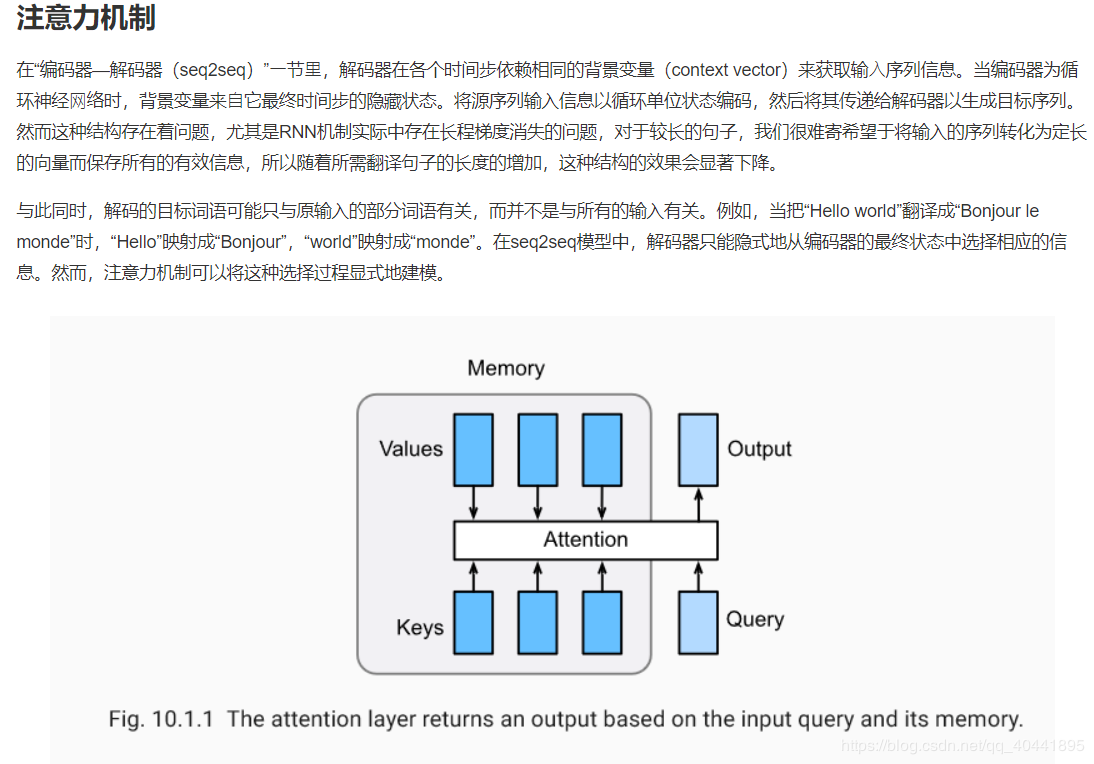
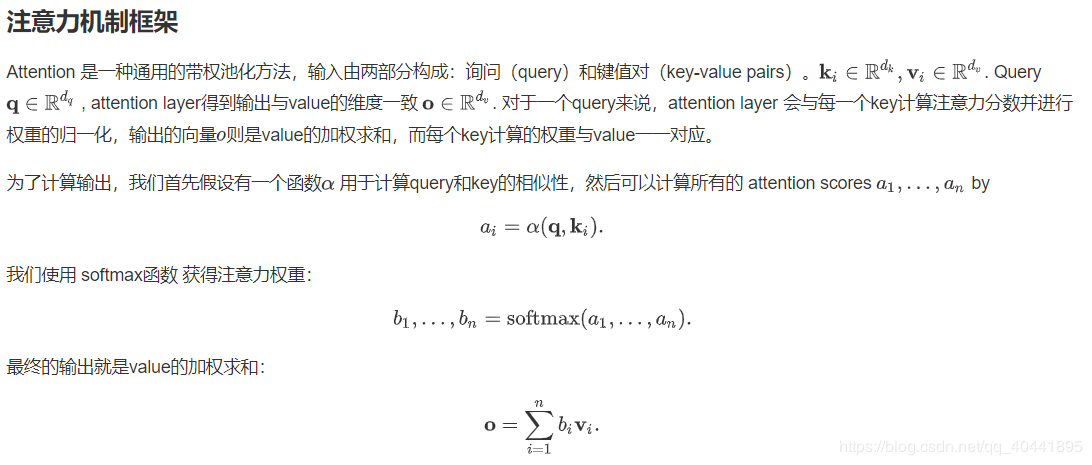
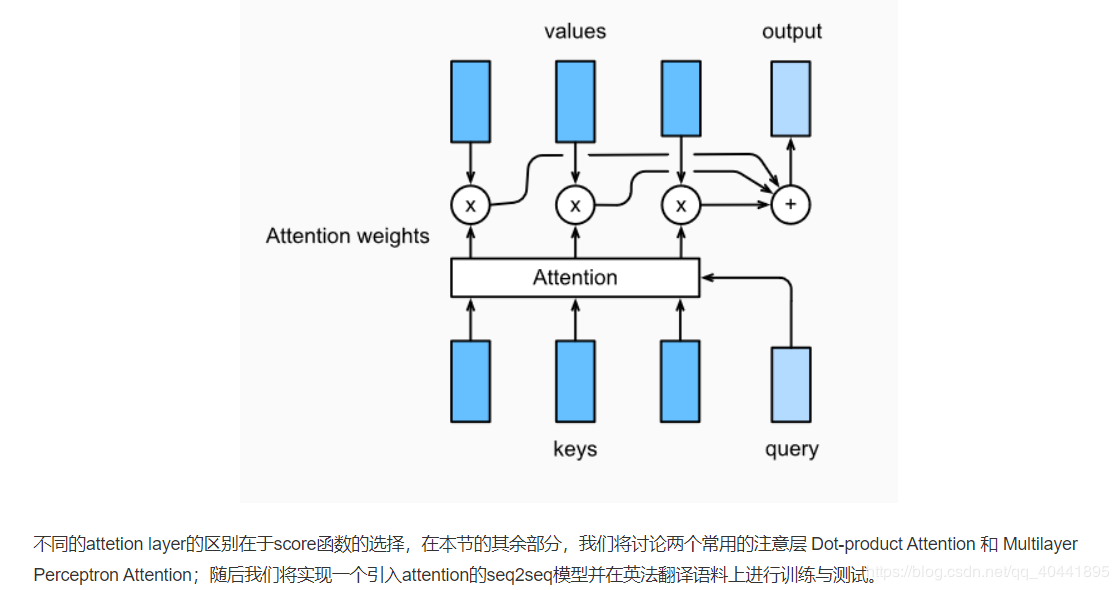
import math
import torch
import torch.nn as nn
import os
def file_name_walk(file_dir):
for root, dirs, files in os.walk(file_dir):
# print("root", root) # 当前目录路径
print("dirs", dirs) # 当前路径下所有子目录
print("files", files) # 当前路径下所有非目录子文件
file_name_walk("/home/kesci/input/fraeng6506")

def SequenceMask(X, X_len,value=-1e6):
maxlen = X.size(1)
#print(X.size(),torch.arange((maxlen),dtype=torch.float)[None, :],'\n',X_len[:, None] )
mask = torch.arange((maxlen),dtype=torch.float)[None, :] >= X_len[:, None]
#print(mask)
X[mask]=value
return X
def masked_softmax(X, valid_length):
# X: 3-D tensor, valid_length: 1-D or 2-D tensor
softmax = nn.Softmax(dim=-1)
if valid_length is None:
return softmax(X)
else:
shape = X.shape
if valid_length.dim() == 1:
try:
valid_length = torch.FloatTensor(valid_length.numpy().repeat(shape[1], axis=0))#[2,2,3,3]
except:
valid_length = torch.FloatTensor(valid_length.cpu().numpy().repeat(shape[1], axis=0))#[2,2,3,3]
else:
valid_length = valid_length.reshape((-1,))
# fill masked elements with a large negative, whose exp is 0
X = SequenceMask(X.reshape((-1, shape[-1])), valid_length)
return softmax(X).reshape(shape)
masked_softmax(torch.rand((2,2,4),dtype=torch.float), torch.FloatTensor([2,3]))

torch.bmm(torch.ones((2,1,3), dtype = torch.float), torch.ones((2,3,2), dtype = torch.float))

# Save to the d2l package.
class DotProductAttention(nn.Module):
def __init__(self, dropout, **kwargs):
super(DotProductAttention, self).__init__(**kwargs)
self.dropout = nn.Dropout(dropout)
# query: (batch_size, #queries, d)
# key: (batch_size, #kv_pairs, d)
# value: (batch_size, #kv_pairs, dim_v)
# valid_length: either (batch_size, ) or (batch_size, xx)
def forward(self, query, key, value, valid_length=None):
d = query.shape[-1]
# set transpose_b=True to swap the last two dimensions of key
scores = torch.bmm(query, key.transpose(1,2)) / math.sqrt(d)
attention_weights = self.dropout(masked_softmax(scores, valid_length))
print("attention_weight\n",attention_weights)
return torch.bmm(attention_weights, value)

atten = DotProductAttention(dropout=0)
keys = torch.ones((2,10,2),dtype=torch.float)
values = torch.arange((40), dtype=torch.float).view(1,10,4).repeat(2,1,1)
atten(torch.ones((2,1,2),dtype=torch.float), keys, values, torch.FloatTensor([2, 6]))

# Save to the d2l package.
class MLPAttention(nn.Module):
def __init__(self, units,ipt_dim,dropout, **kwargs):
super(MLPAttention, self).__init__(**kwargs)
# Use flatten=True to keep query's and key's 3-D shapes.
self.W_k = nn.Linear(ipt_dim, units, bias=False)
self.W_q = nn.Linear(ipt_dim, units, bias=False)
self.v = nn.Linear(units, 1, bias=False)
self.dropout = nn.Dropout(dropout)
def forward(self, query, key, value, valid_length):
query, key = self.W_k(query), self.W_q(key)
#print("size",query.size(),key.size())
# expand query to (batch_size, #querys, 1, units), and key to
# (batch_size, 1, #kv_pairs, units). Then plus them with broadcast.
features = query.unsqueeze(2) + key.unsqueeze(1)
#print("features:",features.size()) #--------------开启
scores = self.v(features).squeeze(-1)
attention_weights = self.dropout(masked_softmax(scores, valid_length))
return torch.bmm(attention_weights, value)

atten = MLPAttention(ipt_dim=2,units = 8, dropout=0)
atten(torch.ones((2,1,2), dtype = torch.float), keys, values, torch.FloatTensor([2, 6]))
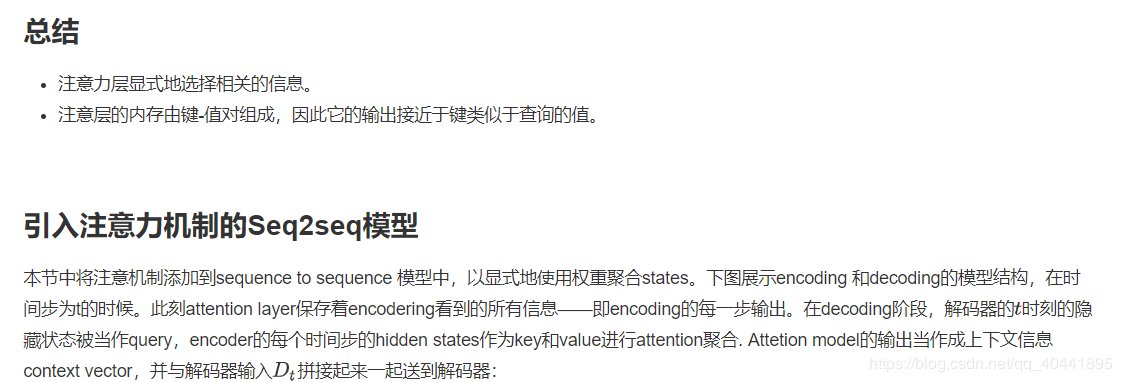
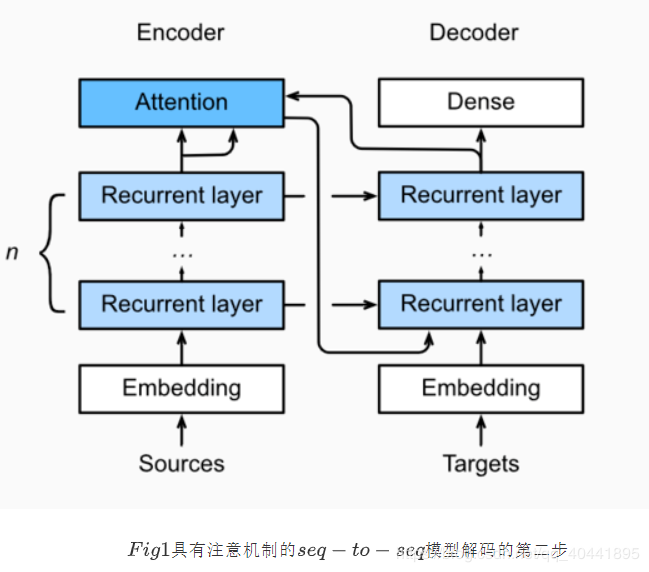
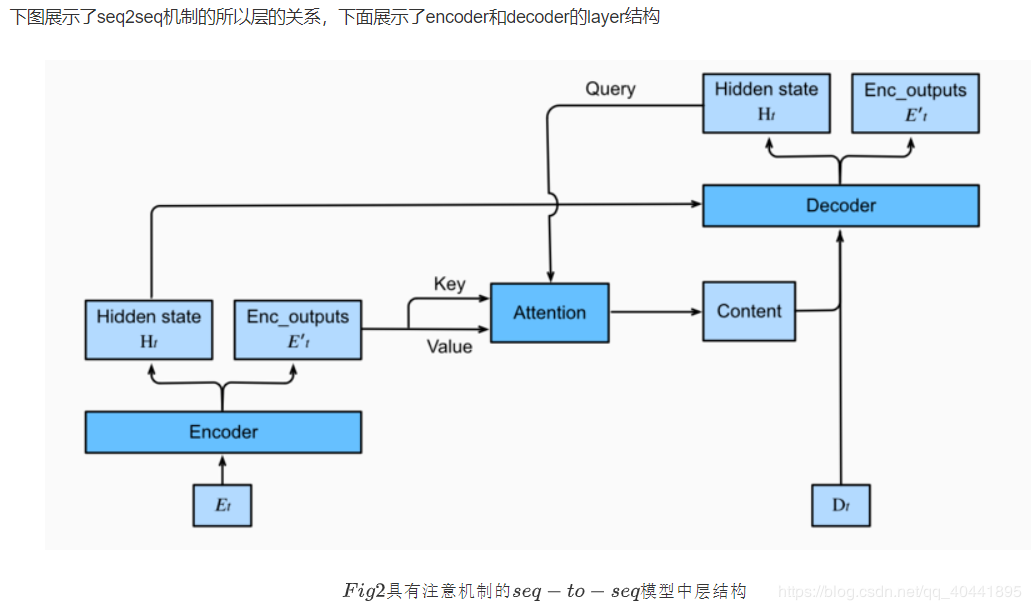
import sys
sys.path.append('/home/kesci/input/d2len9900')
import d2l
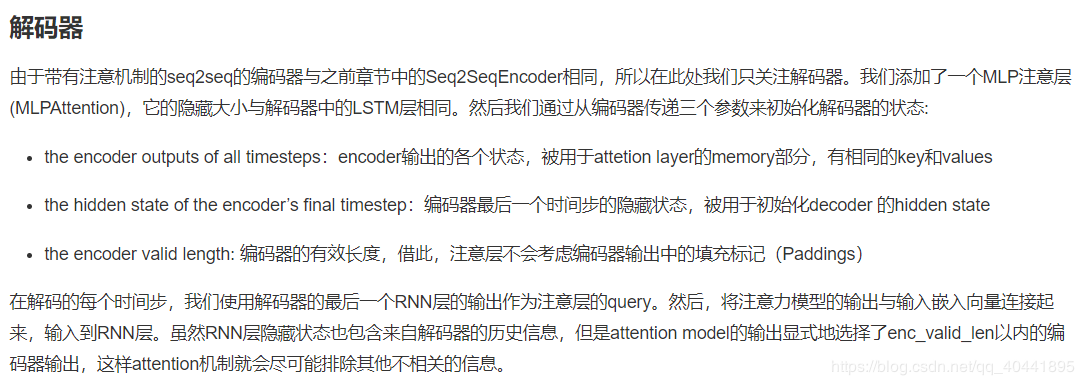
class Seq2SeqAttentionDecoder(d2l.Decoder):
def __init__(self, vocab_size, embed_size, num_hiddens, num_layers,
dropout=0, **kwargs):
super(Seq2SeqAttentionDecoder, self).__init__(**kwargs)
self.attention_cell = MLPAttention(num_hiddens,num_hiddens, dropout)
self.embedding = nn.Embedding(vocab_size, embed_size)
self.rnn = nn.LSTM(embed_size+ num_hiddens,num_hiddens, num_layers, dropout=dropout)
self.dense = nn.Linear(num_hiddens,vocab_size)
def init_state(self, enc_outputs, enc_valid_len, *args):
outputs, hidden_state = enc_outputs
# print("first:",outputs.size(),hidden_state[0].size(),hidden_state[1].size())
# Transpose outputs to (batch_size, seq_len, hidden_size)
return (outputs.permute(1,0,-1), hidden_state, enc_valid_len)
#outputs.swapaxes(0, 1)
def forward(self, X, state):
enc_outputs, hidden_state, enc_valid_len = state
#("X.size",X.size())
X = self.embedding(X).transpose(0,1)
# print("Xembeding.size2",X.size())
outputs = []
for l, x in enumerate(X):
# print(f"\n{l}-th token")
# print("x.first.size()",x.size())
# query shape: (batch_size, 1, hidden_size)
# select hidden state of the last rnn layer as query
query = hidden_state[0][-1].unsqueeze(1) # np.expand_dims(hidden_state[0][-1], axis=1)
# context has same shape as query
# print("query enc_outputs, enc_outputs:\n",query.size(), enc_outputs.size(), enc_outputs.size())
context = self.attention_cell(query, enc_outputs, enc_outputs, enc_valid_len)
# Concatenate on the feature dimension
# print("context.size:",context.size())
x = torch.cat((context, x.unsqueeze(1)), dim=-1)
# Reshape x to (1, batch_size, embed_size+hidden_size)
# print("rnn",x.size(), len(hidden_state))
out, hidden_state = self.rnn(x.transpose(0,1), hidden_state)
outputs.append(out)
outputs = self.dense(torch.cat(outputs, dim=0))
return outputs.transpose(0, 1), [enc_outputs, hidden_state,
enc_valid_len]
现在我们可以用注意力模型来测试seq2seq。为了与第9.7节中的模型保持一致,我们对vocab_size、embed_size、num_hiddens和num_layers使用相同的超参数。结果,我们得到了相同的解码器输出形状,但是状态结构改变了。
encoder = d2l.Seq2SeqEncoder(vocab_size=10, embed_size=8,
num_hiddens=16, num_layers=2)
# encoder.initialize()
decoder = Seq2SeqAttentionDecoder(vocab_size=10, embed_size=8,
num_hiddens=16, num_layers=2)
X = torch.zeros((4, 7),dtype=torch.long)
print("batch size=4\nseq_length=7\nhidden dim=16\nnum_layers=2\n")
print('encoder output size:', encoder(X)[0].size())
print('encoder hidden size:', encoder(X)[1][0].size())
print('encoder memory size:', encoder(X)[1][1].size())
state = decoder.init_state(encoder(X), None)
out, state = decoder(X, state)
out.shape, len(state), state[0].shape, len(state[1]), state[1][0].shape
训练
与第9.7.4节相似,通过应用相同的训练超参数和相同的训练损失来尝试一个简单的娱乐模型。从结果中我们可以看出,由于训练数据集中的序列相对较短,额外的注意层并没有带来显著的改进。由于编码器和解码器的注意层的计算开销,该模型比没有注意的seq2seq模型慢得多。
import zipfile
import torch
import requests
from io import BytesIO
from torch.utils import data
import sys
import collections
class Vocab(object): # This class is saved in d2l.
def __init__(self, tokens, min_freq=0, use_special_tokens=False):
# sort by frequency and token
counter = collections.Counter(tokens)
token_freqs = sorted(counter.items(), key=lambda x: x[0])
token_freqs.sort(key=lambda x: x[1], reverse=True)
if use_special_tokens:
# padding, begin of sentence, end of sentence, unknown
self.pad, self.bos, self.eos, self.unk = (0, 1, 2, 3)
tokens = ['', '', '', '']
else:
self.unk = 0
tokens = ['']
tokens += [token for token, freq in token_freqs if freq >= min_freq]
self.idx_to_token = []
self.token_to_idx = dict()
for token in tokens:
self.idx_to_token.append(token)
self.token_to_idx[token] = len(self.idx_to_token) - 1
def __len__(self):
return len(self.idx_to_token)
def __getitem__(self, tokens):
if not isinstance(tokens, (list, tuple)):
return self.token_to_idx.get(tokens, self.unk)
else:
return [self.__getitem__(token) for token in tokens]
def to_tokens(self, indices):
if not isinstance(indices, (list, tuple)):
return self.idx_to_token[indices]
else:
return [self.idx_to_token[index] for index in indices]
def load_data_nmt(batch_size, max_len, num_examples=1000):
"""Download an NMT dataset, return its vocabulary and data iterator."""
# Download and preprocess
def preprocess_raw(text):
text = text.replace('\u202f', ' ').replace('\xa0', ' ')
out = ''
for i, char in enumerate(text.lower()):
if char in (',', '!', '.') and text[i-1] != ' ':
out += ' '
out += char
return out
with open('/home/kesci/input/fraeng6506/fra.txt', 'r') as f:
raw_text = f.read()
text = preprocess_raw(raw_text)
# Tokenize
source, target = [], []
for i, line in enumerate(text.split('\n')):
if i >= num_examples:
break
parts = line.split('\t')
if len(parts) >= 2:
source.append(parts[0].split(' '))
target.append(parts[1].split(' '))
# Build vocab
def build_vocab(tokens):
tokens = [token for line in tokens for token in line]
return Vocab(tokens, min_freq=3, use_special_tokens=True)
src_vocab, tgt_vocab = build_vocab(source), build_vocab(target)
# Convert to index arrays
def pad(line, max_len, padding_token):
if len(line) > max_len:
return line[:max_len]
return line + [padding_token] * (max_len - len(line))
def build_array(lines, vocab, max_len, is_source):
lines = [vocab[line] for line in lines]
if not is_source:
lines = [[vocab.bos] + line + [vocab.eos] for line in lines]
array = torch.tensor([pad(line, max_len, vocab.pad) for line in lines])
valid_len = (array != vocab.pad).sum(1)
return array, valid_len
src_vocab, tgt_vocab = build_vocab(source), build_vocab(target)
src_array, src_valid_len = build_array(source, src_vocab, max_len, True)
tgt_array, tgt_valid_len = build_array(target, tgt_vocab, max_len, False)
train_data = data.TensorDataset(src_array, src_valid_len, tgt_array, tgt_valid_len)
train_iter = data.DataLoader(train_data, batch_size, shuffle=True)
return src_vocab, tgt_vocab, train_iter
embed_size, num_hiddens, num_layers, dropout = 32, 32, 2, 0.0
batch_size, num_steps = 64, 10
lr, num_epochs, ctx = 0.005, 500, d2l.try_gpu()
src_vocab, tgt_vocab, train_iter = load_data_nmt(batch_size, num_steps)
encoder = d2l.Seq2SeqEncoder(
len(src_vocab), embed_size, num_hiddens, num_layers, dropout)
decoder = Seq2SeqAttentionDecoder(
len(tgt_vocab), embed_size, num_hiddens, num_layers, dropout)
model = d2l.EncoderDecoder(encoder, decoder)
训练和预测
d2l.train_s2s_ch9(model, train_iter, lr, num_epochs, ctx)
for sentence in ['Go .', 'Good Night !', "I'm OK .", 'I won !']:
print(sentence + ' => ' + d2l.predict_s2s_ch9(
model, sentence, src_vocab, tgt_vocab, num_steps, ctx))
作者:qq_40441895